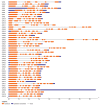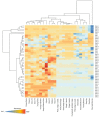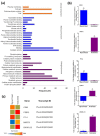Cysteine-Rich Receptor-Like Kinase Gene Family Identification in the Phaseolus Genome and Comparative Analysis of Their Expression Profiles Specific to Mycorrhizal and Rhizobial Symbiosis
- PMID: 30658517
- PMCID: PMC6356535
- DOI: 10.3390/genes10010059
Cysteine-Rich Receptor-Like Kinase Gene Family Identification in the Phaseolus Genome and Comparative Analysis of Their Expression Profiles Specific to Mycorrhizal and Rhizobial Symbiosis
Abstract
Receptor-like kinases (RLKs) are conserved upstream signaling molecules that regulate several biological processes, including plant development and stress adaptation. Cysteine (C)-rich receptor-like kinases (CRKs) are an important class of RLK that play vital roles in disease resistance and cell death in plants. Genome-wide analyses of CRK genes have been carried out in Arabidopsis and rice, while functional characterization of some CRKs has been carried out in wheat and tomato in addition to Arabidopsis. A comprehensive analysis of the CRK gene family in leguminous crops has not yet been conducted, and our understanding of their roles in symbiosis is rather limited. Here, we report the comprehensive analysis of the PhaseolusCRK gene family, including identification, sequence similarity, phylogeny, chromosomal localization, gene structures, transcript expression profiles, and in silico promoter analysis. Forty-six CRK homologs were identified and phylogenetically clustered into five groups. Expression analysis suggests that PvCRK genes are differentially expressed in both vegetative and reproductive tissues. Further, transcriptomic analysis revealed that shared and unique CRK genes were upregulated during arbuscular mycorrhizal and rhizobial symbiosis. Overall, the systematic analysis of the PvCRK gene family provides valuable information for further studies on the biological roles of CRKs in various Phaseolus tissues during diverse biological processes, including Phaseolus-mycorrhiza/rhizobia symbiosis.
Keywords: CRKs; Cysteine (C)-rich receptor-like kinases; Phaseolus; RLK; Rhizobium; common bean; genome-wide identification; legume; mycorrhizal fungi.
Conflict of interest statement
The authors declare no conflict of interest.
Figures






Similar articles
-
CRK12: A Key Player in Regulating the Phaseolus vulgaris-Rhizobium tropici Symbiotic Interaction.Int J Mol Sci. 2023 Jul 21;24(14):11720. doi: 10.3390/ijms241411720. Int J Mol Sci. 2023. PMID: 37511479 Free PMC article.
-
Comprehensive Analysis of Phaseolus vulgaris SnRK Gene Family and Their Expression during Rhizobial and Mycorrhizal Symbiosis.Genes (Basel). 2022 Nov 13;13(11):2107. doi: 10.3390/genes13112107. Genes (Basel). 2022. PMID: 36421782 Free PMC article.
-
Nitrate regulates rhizobial and mycorrhizal symbiosis in common bean (Phaseolus vulgaris L.).J Integr Plant Biol. 2014 Mar;56(3):281-98. doi: 10.1111/jipb.12156. Epub 2014 Feb 25. J Integr Plant Biol. 2014. PMID: 24387000
-
Cysteine-rich receptor-like protein kinases: emerging regulators of plant stress responses.Trends Plant Sci. 2023 Jul;28(7):776-794. doi: 10.1016/j.tplants.2023.03.028. Epub 2023 Apr 26. Trends Plant Sci. 2023. PMID: 37105805 Review.
-
Transcription factors network in root endosymbiosis establishment and development.World J Microbiol Biotechnol. 2018 Feb 15;34(3):37. doi: 10.1007/s11274-018-2418-7. World J Microbiol Biotechnol. 2018. PMID: 29450655 Review.
Cited by
-
New Insights into the Mechanism of Trichoderma virens-Induced Developmental Effects on Agrostis stolonifera Disease Resistance against Dollar Spot Infection.J Fungi (Basel). 2022 Nov 10;8(11):1186. doi: 10.3390/jof8111186. J Fungi (Basel). 2022. PMID: 36354953 Free PMC article.
-
More questions than answers: insights into potential cysteine-rich receptor-like kinases redox signalling in Arabidopsis.Plant J. 2025 Apr;122(2):e70176. doi: 10.1111/tpj.70176. Plant J. 2025. PMID: 40300149 Free PMC article. Review.
-
Identification and characterization of the CRK gene family in the wheat genome and analysis of their expression profile in response to high temperature-induced male sterility.PeerJ. 2024 May 7;12:e17370. doi: 10.7717/peerj.17370. eCollection 2024. PeerJ. 2024. PMID: 38737737 Free PMC article.
-
Integrated omics and machine learning-assisted profiling of cysteine-rich-receptor-like kinases from three peanut spp. revealed their role in multiple stresses.Front Genet. 2023 Sep 20;14:1252020. doi: 10.3389/fgene.2023.1252020. eCollection 2023. Front Genet. 2023. PMID: 37799143 Free PMC article.
-
Genome-wide identification and molecular characterization of CRK gene family in cucumber (Cucumis sativus L.) under cold stress and sclerotium rolfsii infection.BMC Genomics. 2023 Apr 26;24(1):219. doi: 10.1186/s12864-023-09319-z. BMC Genomics. 2023. PMID: 37101152 Free PMC article.
References
-
- Genre A., Chabaud M., Balzergue C., Puech-Pagès V., Novero M., Rey T., Fournier J., Rochange S., Bécard G., Bonfante P., et al. Short-chain chitin oligomers from arbuscular mycorrhizal fungi trigger nuclear Ca2+ spiking in Medicago truncatula roots and their production is enhanced by strigolactone. New Phytol. 2013;198:190–202. doi: 10.1111/nph.12146. - DOI - PubMed
-
- Bourdais G., Burdiak P., Gauthier A., Nitsch L., Salojärvi J., Rayapuram C., Idänheimo N., Hunter K., Kimura S., Merilo E., et al. Large-Scale phenomics identifies primary and fine-tuning roles for CRKs in responses related to oxidative stress. PLoS Genet. 2015;11:e1005373. doi: 10.1371/journal.pgen.1005373. - DOI - PMC - PubMed
Publication types
MeSH terms
Substances
LinkOut - more resources
Full Text Sources
Other Literature Sources

